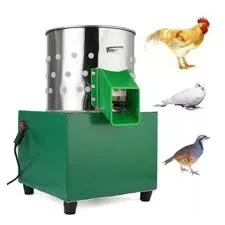How to Perfectly Scald Chickens for Processing and Preparation
Oct . 17, 2024 02:11 Back to list
How to Perfectly Scald Chickens for Processing and Preparation
The Process and Importance of Chicken Scalder in Poultry Processing
The poultry industry plays a vital role in global food production, and among the myriad of processes involved in transforming a live bird into a market-ready product, chicken scalding stands out as a critical step. Scalding not only prepares chickens for plucking but also ensures that the meat retains its quality, texture, and taste. This article explores what chicken scalding entails, the methods employed, and its significance in poultry processing.
What is Chicken Scalding?
Chicken scalding is the process of submerging freshly slaughtered chickens in hot water. This is typically done after the birds have been bled out and before they undergo plucking. The primary purpose of scalding is to loosen the feathers, making it easier to remove them without damaging the skin. However, scalding serves additional functions, impacting the overall quality of the chicken.
Methods of Scalding
There are two predominant methods of scalding dry scalding and wet scalding
.1. Wet Scalding This is the most common technique used in commercial operations. The birds are immersed in water heated to a specific temperature, usually between 140°F to 160°F (60°C to 71°C). The duration of immersion depends on several factors, including the temperature of the water and the size of the chickens. Wet scalding not only helps in feather removal but also aids in the denaturing of certain proteins, resulting in a more tender meat texture.
2. Dry Scalding Although less common, dry scalding involves exposing birds to hot air rather than water. This process is often used for specialty products or organic chicken processing, where water usage must be minimized due to environmental concerns. Dry scalding can preserve the natural flavor of the chicken, but it requires careful regulation of temperature and exposure time to prevent cooking the meat.
Importance of Scalding
chicken scalder

The significance of chicken scalding extends beyond just feather removal. Here are several key points highlighting its importance in poultry processing
1. Efficient Feather Removal Proper scalding allows for a more efficient plucking process. Feathers that are not adequately loosened can lead to significant meat loss, as plucking can damage the skin and flesh underneath. By ensuring that the feathers come off cleanly, processors can maximize yield.
2. Meat Quality Scalding prepares the bird for plucking in a way that helps retain the quality of the meat. The right temperature and technique ensure that the skin does not tear and that the meat remains intact, leading to a better presentation for consumers.
3. Microbial Control Scalding at high temperatures can help in reducing microbial loads on the surface of the chicken. Although further processing steps are essential for food safety, scalding plays a part in lowering the risk of contamination during the initial processing stages.
4. Preservation of Flavor The scalding process denatures proteins in the skin and meat, which can enhance flavor and texture. Properly scalded chicken tends to be more succulent and flavorful, attributes that are highly valued by consumers.
5. Regulatory Compliance Many countries have specific regulations regarding processing methods in the poultry industry. Proper scalding techniques ensure compliance with food safety standards, thus safeguarding public health.
Conclusion
Chicken scalding is more than a mere preliminary step in poultry processing; it is a nuanced process that impacts the efficiency of feather removal, the quality and safety of the meat, and the overall productivity of the operation. By understanding and mastering scalding techniques, poultry processors can ensure they deliver high-quality products that meet consumer demand while upholding food safety standards. As the poultry industry continues to evolve, innovations in scalding technologies may further enhance the efficiency and effectiveness of this critical step, solidifying the importance of scalding in poultry processing for years to come.
-
Hot Sale 24 & 18 Door Rabbit Cages - Premium Breeding Solutions
NewsJul.25,2025
-
Automatic Feeding Line System Pan Feeder Nipple Drinker - Anping County Yize Metal Products Co., Ltd.
NewsJul.21,2025
-
Automatic Feeding Line System Pan Feeder Nipple Drinker - Anping County Yize Metal Products Co., Ltd.
NewsJul.21,2025
-
Automatic Feeding Line System - Anping Yize | Precision & Nipple
NewsJul.21,2025
-
Automatic Feeding Line System - Anping Yize | Precision & Nipple
NewsJul.21,2025
-
Automatic Feeding Line System-Anping County Yize Metal Products Co., Ltd.|Efficient Feed Distribution&Customized Animal Farming Solutions
NewsJul.21,2025






